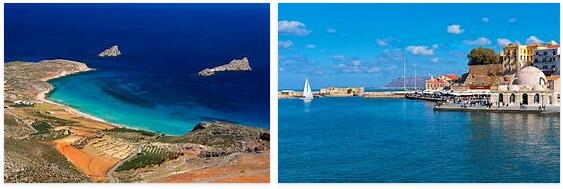Crete – Gouves
Gouves is a resort place with beautiful sandy beaches and olive groves and vineyards. Located 18 km east of the capital of the island of Crete.
Gouves village consists of two parts: lower – Kato and upper – Panno. Upper Gouves is a traditional Cretan village with traditional taverns and many old churches located around it. Walking through the old part of the resort, admiring the white houses and narrow streets, you will be transported to the past centuries, when the ancient Greeks still walked here. Kato Gouves is located on the shores of picturesque bays with sandy and pebble beaches, surrounded by olive groves. The coastal zone is filled with hotels and apartments of all possible levels – from five-star hotels to camping. There are many cafes, restaurants and bars in Kato Gouves, most of which are located on the main street and on the promenade. Traditional taverns alternate with pizzerias, bars and Chinese restaurants.
In Pano Gouves, known since the 14th century, you will immerse yourself in the atmosphere of traditional, non-touristic Crete: narrow streets, ivy-covered houses and several temples of outstanding beauty.
The sandy beach of Gouves has been awarded the European Blue Flag. Pure turquoise water surface of the sea, dense emerald green tree crowns and snow-white warm sand – this is all Gouves. The beach is long and equipped with everything you need: rental of umbrellas and sun loungers, showers, changing rooms, bars and cafes. There are also water activities on the beach: water skiing, bananas, parachutes, as well as the Big Blue diving center. Nearby is Cretaquarium – the Cretan Aquarium, which can be reached on foot along the coastline or by bus.
A few kilometers inland, a kilometer northwest of the village of Skotino, is the cave of St. Paraskeva, the same name for the temple standing above it. The cave is one of the largest and most impressive in Crete, measuring about 160 meters long and 36 meters wide. It is filled with stalactites and stalagmites of bizarre shape.
Crete – Heraklion
Heraklion, the capital of Crete, is the largest city on the island. Once this city served as the harbor of the ancient Minoan city of Knossos. The history of Heraklion is very diverse. At the beginning of the 9th century AD, the developed Byzantine port was taken by the Arabs, who gave the city a new name – Rabd el-Khandak (the Byzantines shortened it to Khandakas, and the Venetians renamed it Candia). It was under the name Candia that Heraklion entered the history of the Middle Ages. In 1661, after the assault, Nikiforos Foka (Byzantine commander) recaptured the city from the Arabs. During the Venetian rule, Candia became the capital of Crete and its main fortress. In 1669, the most difficult page in the history of Crete begins – the Ottoman rule. The city received the status of “pashalyk” – the area directly controlled by the pasha. It was during the Turkish rule because
Only in 1889 Crete was liberated from the Turks. And only then the city was given its ancient name – Heraklion. The most interesting are the following historical and architectural monuments of Heraklion – the Church of St. Titus, the fountain of Morosini, the small church of Agia Deka, the church of St. Catherine, where the great artist El Greco was educated.
Crete – Kavros
4 km from Georgioupolis there is a small village that has turned into a resort area – Kavros. This place has become quite popular for those who like to combine luxury holidays in good hotels with car travel. From Kavros, every hour, a “children’s” train with open trailers leaves for the mountains, which moves along different routes, one of which is a visit to a fresh lake in Crete – Lake Kournas. This lake is located in the foothills, 4 km from the tourist resort of Georgioupolis.
Lake Kournas is of volcanic origin. Its perimeter is about 3.5 km. and there is a lake at 23-25 m above sea level. Here water is collected from mountain springs. The waters of both springs come from a deep abyss at a place called Dafnomadara. The depth of the lake is 26 meters. An underwater river emerges from it through a cave after 4 km and flows into the sea.
Some believe that the name of the lake comes from the same name of the village of Kournas. The ancient name of the lake was different – Korissia. Subsequently, the Arabs renamed it Kurnas. Kurnas means lake in Arabic. There are no fish in the lake, but freshwater turtles are in large numbers. After visiting Lake Kournas, you can rent a water bike, ride along the lake and swim.
Attention should be paid to visiting Argyroupolis, famous for its fresh springs, which were artificially decorated by locals into small ponds, small waterfalls, magnificently descending cascades of water. 2 km from the springs of Argyroupolis is the ancient city of Lappa, famous for its well-preserved Roman baths with colorful mosaics and avocado groves.
